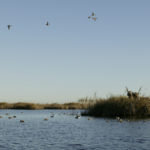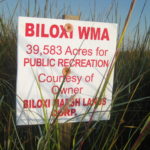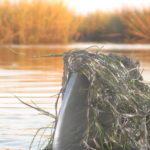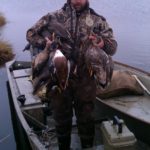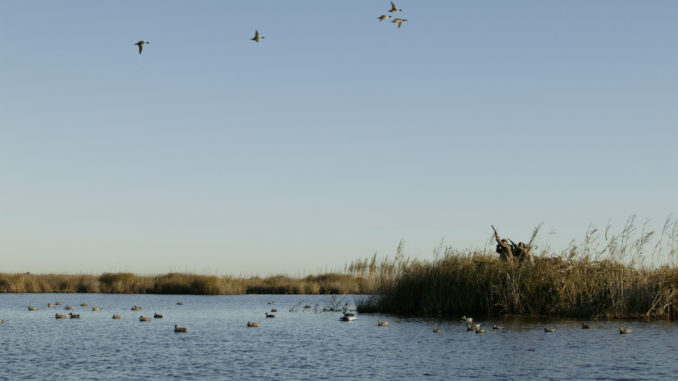
Duck enthusiasts who frequent the Biloxi Marsh year after year say it provides a rewarding and productive hunting experience.
As we soak our waders into yet another duck hunting season, many of us have already begun to reap the residuals from the productive ponds on our leases, while others have had ample time to allow their sore shooting shoulders to heal after experiencing the great pleasure of bagging the limits that come along with a guided trip.
There’s no hard feelings for the duck enthusiast who enjoys the fruits of his labor as a lessee, and you’d be hard pressed to find a hunter who’s going to blame another for paying someone to set the decoys, blow into the call and clean up after all the mess is made.
But as duck stamp purchase numbers in Louisiana will show, there would be many mud boats, shotguns and pirogues going unblemished by the marshes if the hunting trips ended with just leases and guides.
So, who do the other stamp purchases belong to? They are claimed by the hunter who was lucky enough to cut a few feathers on his friend’s lease in Delacroix one morning when a family member couldn’t make it, and to the hunter who clamors loudly enough to land a bunk at his boss’s camp in Lafitte, to be dropped in a blind before the sun comes up the next day.
Sure, we all buy our stamps as the season approaches, and we all manage to put them to use one way or another. But the fact remains that some duck hunters enjoy having their towers buzzed by flocks of green heads on repeated mornings, while others of us wait in contingencies, hoping to be swooned by a flock of swiftly swooping green wingers only once a year.
If an overly stipulated seasonal duck hunting plan just does not pack your freezer enough, then the 39,583 acres that sit wedged between the Mississippi River Gulf Outlet and Lake Borgne, known as the Biloxi Marsh, might serve as a very viable option for you. The Biloxi Marsh is a public wildlife management area, run by the Louisiana Department of Wildlife and Fisheries, in upper St. Bernard Parish. It is open for duck hunting to anyone who qualifies to purchase a federal and state duck stamp, along with the added WMA permit.
Those who frequent the Biloxi Marsh year after year say that with diligent scouting and hard work, a duck hunt in this WMA can be a productive and rewarding experience.
“We started scouting this area about 10 years ago when our lease in Lake Hermitage became too much money and trouble for what it was producing,” says Neil Gauthier, an avid Biloxi Marsh duck hunter and former biologist with the Wildlife and Fisheries.
Gauthier explains that it all started with an aerial map, a GPS and the determination needed to scout an area as large as 35,000 football fields. He spent several mornings during duck season without taking a gun along or bringing a decoy to hunt over. He would launch his boat out of Hopedale, cross the MRGO on Bayou La Loutre, run his way down to Bayou St. Malo and meander into the Biloxi Marsh.
For duck enthusiasts, like the mud boats full of hunters that launch out of either Hopedale or Shell Beach, or the ones who are tolerant and safe enough to make the trip into Biloxi Marsh across a choppy Lake Borgne from the Rigolets, to sit back in their boats and simply bird watch is something that takes patience.
“We would nose the boat up into the marsh when we’d see them flying, and just wait to see where they’d land, and then we’d mark it on GPS,” says Gauthier, who admits that there were times when he wished he had ventured to a few select spots a little earlier in the morning with decoys and shells.
But there were many elements that he was learning about and conditioning himself for along the way.
Scouting the Biloxi Marsh involves a little more than just finding a pond to toss your decoys into and locating a slough to park your pirogue in while you make your calls and take your shots. Chock full of arteries running this way and that, there can be mud flats a hundred yards from the deep bayou you’re running in, or dead ends just a cut around the corner of a canal that feels like it will go on for miles.
There are also damns and weirs that have victimized the hulls and outboards of many boats. It’s easy for the mazy marsh to mislead you, so it is important to take your time when winding through on your first few trips.
A critical part of your scouting is to locate these areas on maps provided by the LDWF before heading out, and mark them again on GPS during well-lit hours. It’s also just as important to mark the boundaries of the WMA; with so many acres to explore, it is very easy to confuse private land for public. Taking the time to do these things will eliminate headaches when you begin hunting, and it will make it immensely safer.
After feeling comfortable with well-established, safe bearings in the area, it wasn’t long before Gauthier and his duck hunting comrades were in the mix of things. The second split on the same year of the initial scouting excursion was open season for them, but they didn’t get to the ducks without more preparation.
“I can remember us dropping the boat in the water at Breton Sound one morning and having a hard time getting our GPS to power up,” recalls Nat Rondey, Neil’s brother-in-law and fellow duck hunting enthusiast.
Even after 10 years worth of runs, up and down Bayous La Loutre and St. Malo, and making so many passes through the Biloxi Marsh that his GPS tracks look like swollen veins popping off the screen, Gauthier doesn’t lose respect for the haul it takes to get there.
“I would caution you if you wanted to make that trip in the dark without an updated track on your GPS,” he said.
“A Q-beam works well on a duck-hunting trip, but it’s not going to help you remember the stump you marked, or even one of the many second options for ponds that you marked with waypoints,” adds Rondey.
Second options are a key element to hunting on a WMA. One thing to always keep top of mind when setting out on a trip is that no matter how you mark it or how much you want to hunt it, that favorite pond you have is not yours. Secret honey holes can be fairly explored and optioned by somebody else; therefore, it is very important to have a Plan B, and even a Plan C and D. Ample time to get where you’re going also serves as an advantage, especially when hunting the Biloxi Marsh.
“People will wake up early and get there before you, but we all respect one another out here,” says Rondey. “There’s plenty enough to go around for everyone.”
Plenty indeed; virtually untainted by pipeline canals that create water flow in an unnatural way, the Biloxi Marsh is a pristine habitat that thrives pretty much as nature intended. Free from a high turbidity, the marsh’s cleanliness allows submerged aquatic vegetation (SAV) to thrive. Ponds are plentiful with widgeon grass, which is a common food for the ducks that migrate to the area.
“Gadwall, widgeon, teal — they will hold up in here because it provides a nice habitat for them,” said Gauthier. “The grass is a big positive, but these species of ducks will munch on the snails and invertebrates that are in here too.”
Limits of these ducks can be bagged on a regular basis during the duck hunting season in Biloxi Marsh. Using smart hunting tactics can only improve your odds of having grilled duck wraps later in the evening.
“A pond with widgeon grass in about 6 to 12 inches of water is usually a good indicator of a productive spot,” Gauthier said.
“There can be a little boat traffic along the main canals and passes, because people are catching trout and reds out here too, so it’s beneficial to a hunter to try and find a pond off the beaten path, especially for the second split,” adds Rondey.
Finding ponds is something that the duo still prides themselves in doing even after hunting the area all of these years. They look for areas concentrated with coot when all else fails.
The Biloxi Marsh has no shortage of American coot, better known in most hunting circles as poul d’eau. As duck hunters know, this species of bird migrates south for the same food as a duck. Therefore, spotting the less agile bird is not only a good sign that ducks might be in the area, but also another option to put food on the plate, as their limits are much higher than ducks.
“We’ve hunted many ponds that get ganged up with poul d’eau,” said Gauthier. “The ducks react to their movement and dark color, and key in on that spot.”
The key thing is that the ducks aren’t seeing Gauthier before they see the coot. He uses a “leaner,” made of two-by-fours and plywood, which he brings with him, and he camouflages it with the grasses that are naturally around the Biloxi Marsh. Bringing something that he can easily use and remove helps avoid conflict in not complying with the restrictions that WMAs have on building permanent blinds.
“There’s not a ton of roseau cane out here, so we’re not hunkering down in something like a roseau blind that might stand out like a sore thumb to the duck,” adds Rondey.
The same hunting savvy applies to their theory for decoys and calling.
“I’ve heard of people taking mallards and pintails in the Biloxi Marsh, but it seems to be the anomaly, so I try to attract what I see,” said Gauthier, who uses mostly gadwall and teal decoys, mixed in with a few coot and widgeon.
He also advises the use of a low-tone call, like a gadwall call or teal whistle, and to not overdo it, especially late in the season.
“I don’t come to the Biloxi Marsh and blow a mallard call too much because it’s just not what you’re going to see,” he said, explaining that what he puts in his bag is more about good productive duck hunting and less about glamour.
With bagging ducks being the operative mission of any duck hunter, the Biloxi Marsh comes through. After taking your time to safely scout the area and hone in on where the ducks are landing, you too can chime in on those Monday morning conversations at the coffee dispenser had by your co-workers about how hard it is to close their freezers stuffed with ducks.
Breton Sound Marina or Blackie Campo’s serve as the easiest ways to access the area, giving you about a five-mile boat ride onto the WMA. With a little more risk involved, northshore residents can launch out of the Rigolets Marina and enter into Biloxi Marsh across Lake Borgne.
In a time where duck stamp purchases are down in Louisiana, the Biloxi Marsh offers the perfect opportunity for people to cut their teeth and see if it’s a hobby worth further exploring.
And for those of us who buy the stamp every year, with eternal optimism that a friend will toss us in the blind with them, save the excuses for someone else with an empty freezer; you can have a sore shooting shoulder too. Gas up your boat, freshen the batteries in your GPS and head to upper St. Bernard for a scouting trip, because the Biloxi Marsh is accessible to you.
No lease, no problem.
Biloxi Marsh Dos and Don’ts
DO…
Purchase a WMA permit before hunting ($15)
Scout the area during well lit hours
Use a GPS to create tracks to follow
Locate and mark the WMA boundaries on a map
Have second and third hunting options
Find ponds away from the main traffic canals
Look for Coot and widgeon grass in six to twelve inches of water
Use Gadwall, Teal and Widgeon decoys and calls
DON’T…
Rush and run into mud flats, damns, and weirs
Confuse public land for private land
Travel without an updated GPS track and a Q-beam
Sweat it if someone else is in “your pond”
Build a permanent blind
Wait for your boss or friend to let you tag along for a spot on their lease, when the Biloxi Marsh offers you 39,583 acres of pristine marshland to hunt
